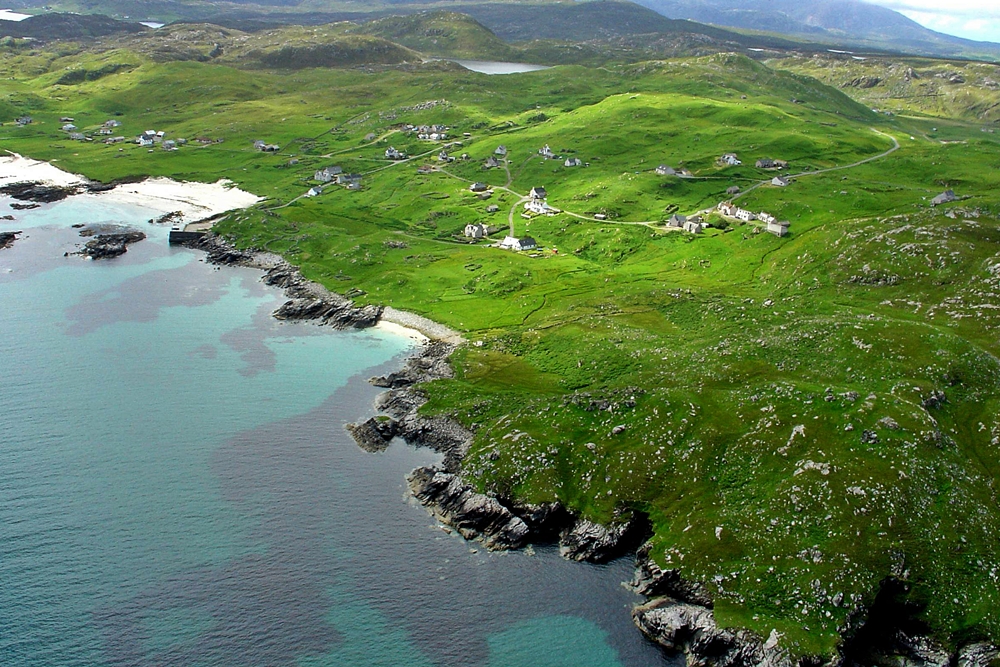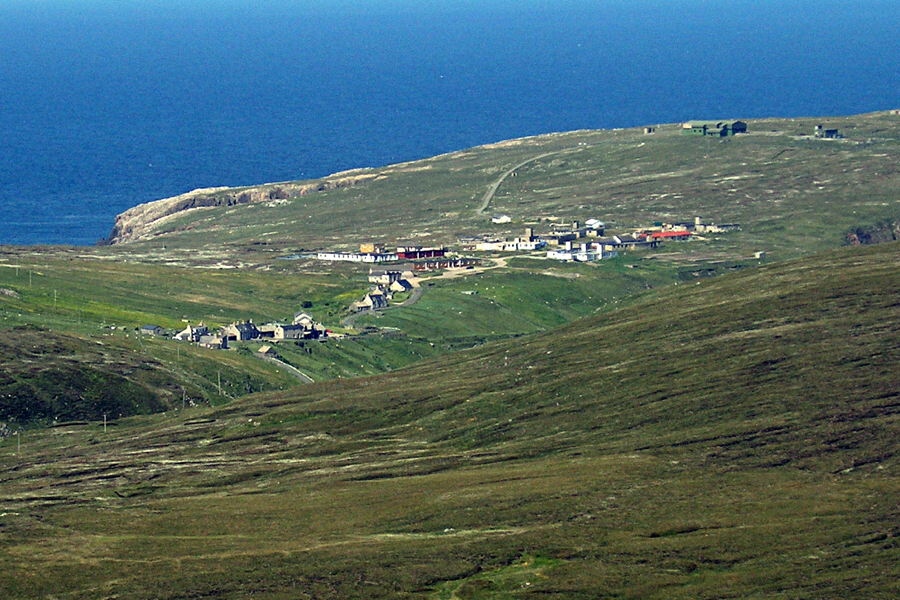Category: Land Issues (page 2)
The Departure of the Barlow, 1851
Waiting for the Barlow
Rev David Watson’s Boundary Dispute
David Watson was ordained as minister of Uig in 1845 but as the congregation had mostly migrated to the Free Church, his Church remained largely empty. He was at odds with the people and the estate, as the following notes in the 1851 diary (published by Acair) of the Chamberlain John Munro Mackenzie attest:
Thursday 13 February
Walked to the Manse of Uig and found Mr Watson busy planting potatoes and clearing his arable land of Stones with a number of men employed. Went to the Parish School [at Taigh Chiosamuil] & found it quite crowded there being more than 40 scholars present, and on enquiring the cause was told that Mr Watson gave notice to the people that unless they sent their children to school he would pindfold every sheep & cow of theirs he found on his grass – He expects to get the parents to attend his Church in the same way but I fear he will be disappointed.
Monday 24 March
Went to office and was engaged meeting parties viz… Rev Mr Watson regarding claim for damages for not clearing his farm of Mr Mitchell and small tenants at Whitsunday last, tho’ he agreed and wished to accommodate Mitchelll – Got him to sign a Minute drawn up by Mr [Donald] Munro agreeing to withdrawing his claim & promised to give him the small place of Miavaig which lies into his farm, there are three small tenants here at present occupying it who can be removed to Carishader in place of those going to America.
Thursday 15 May
Went to office and was engaged meeting & paying Ministers Stipends & Schoolmasters salaries — The Rev Mr Watson produced a most extraordinary a/c of £31 made up of various idle claims for damages for mans not being repaired, damages to pasture etc etc which I denied & refused payment in toto and stated to Mr Watson my surprise at his presenting such an a/c – He replied that he would not have done so but that he was hard pressed for cash, having to pay the whole of his stipend for his stock, I offered to give him some delay in the payment of £20 to £30 if he withdrew the a/c which he refused but wished to refer it which I refused as I considered the whole to be absurd –
Uig Deforcers Refusing to Appear, 1885
Letter from Reef, 1920
The Charge Sheet: We Have Waited Long Enough (1913)
On the day in November 1913 when the Reef Raiders drove the stock from Reef Farm, the local Constable made the following report (the list doesn’t correspond exactly to the men identified in the photo):
Charge, Breach of the Peace
Police Station
Miavaig, 28th November 1913
Sir,
I beg to report to you that between the hours of 10am and 1pm on Friday the 28th day of November 1913, on Reef Farm, occupied by Alexander Macrae, Farmer in the Parish of Uig
1. Malcolm Macritchie (64), Married, Squatter, Fisherman, Kneep
2. Allan Morrison (56), Married, Crofter, No 3 Kneep
3. Donald Morrison (49), Married, Squatter, Fisherman, No 13 Kneep
4. Murdo Macdonald (52), Married, Squatter, No 2 Kneep
5. John Morrison (48), Single, “alias” Cooper, No 13 Kneep
6. Murdo Mackay (25), Single, (Angus Son), No 30b Valtos
7. Donald Matheson (54), Married, Squatter, Fisherman, Valtos
8. Alexander Mackay (41), Married, Squatter, Fisherman, Valtos
9. Alexander Macdonald (60), Married, Squatter, Fisherman, Valtos
10. Angus Mackay (26), Single, (Norman Son), Fisherman, Valtos
11. Norman Mackay (24), Single, (Malcolm Son), Fisherman, Valtos
12. Donald Morrison (23), Single (Malcolm Son), Fisherman, Valtos
13. James Morrison (20), Single (Murdo Son), Fisherman, Valtos
14. Donald Maclennan (18), Single (Widow John Son), Valtos
all in the Parish of Uig.
Did form in a body and forcibly and unlawfully enter said farm, there gathered together all the sheep about 200 in number, and 5 head of cattle, and drove them to the march stone dyke which they knocked down, and forced them over the broken wall, thereafter drove them together across the moor through Kneep and Uigen to Miavaig public road, thence along the road through Valtos Glen to Timsgarry Farm, occupied by John Macrae, Farmer, all to the terror and alarm of both farmers, and in breach of the public peace.
The Reef Raiders
Valtos, Kneep and Reef Grazings, 1959
Rental Paid in 1725
An Dotair Ruadh
(picture of Valtos and Kneep by Chris Murray)
An Dotair Ruadh, Donald Macaulay, seventh in line from Dòmhnall Càm, was the son of Dòmhnall mac Sheorais, the tacksman of Linshader who himself became something of a legend because of his size and strength. His son has come down in tradition as equally renowned, but for being something of a chancer. He was a brother of Lily Macaulay who married Rev Robert Finlayson of Lochs, and it seems was also a cousin of Mac an t-Sronaich.
William Matheson reports that he was a small man in black with a red beard and a fiery temper. He studied medicine at Aberdeen but never practiced formally, apparently because he had been expected to succeed Dr Miller in Stornoway and when he was disappointed, he turned to farming instead.
He took a series of tacks, and seems to have made a practice of withholding the rent because of some alleged failure of the proprietor, and going to court over it.
Kneep Crofts in 1959
“Strange Conduct of Lewis Crofters”
Highland News, Monday 13 October, 1884:
The Northern Chronicle publishes the following sensational statement which we trust is somewhat exaggerated:– Mr Wm Mackay, Chamberlain of the Lews, has for some time back been engaged in visiting the different parts of the island for the purpose of collecting rents. On Monday last week [30 September 1884] he left for Uig, the people of which district were expected, as customary, to come forward and pay their rents on the following day. The Chamberlain was at Miavaig on Tuesday, to which place a large gathering of crofters and young men marched in a body carrying two banners, on one of which was written “Down with the Landlords” while the other had inscribed on it a Gaelic motto to the effect that the people were stronger than the proprietors. These banners were conspicuously planted in close proximity to Miavaig House, while the people all clustered together on a hillock within a short distance of the road.
The crofters were repeatedly asked to come forward to explain the object of their demonstration, but none answered to the call, until Mr Mackay, recognising one of the men, called him by name, when he came forward and handed the Chamberlain a paper containing requests to the effect that they (the crofters) required all the squatters in the Uig district to be removed off their lands and provided with lands elsewhere; also, that statements be furnished accounting for the expenditure of the school rates, taxes, and road assessments collected for a number of years back; and further that the present holdings of the crofters be increased to the same extent as those occupied by their fore-fathers, and to be held at the old rents.
Meeting at Islivig School, 1908
Aird Uig in 1959
A chapter from Uig, a Hebridean Parish (1960) by Madge Phillips.
The little township of Aird is an isolated and old-established crofting settlement along the western side of the steep and narrow valley of the Amhainn Gil na h-Airde three miles north of Crowlista. After leaving Loch Meacheit, the river flows northward through a gorge (at the mouth of which are the ruins of the old corn-mill) then across a narrow flood-plain into the rocky bay of Camus na h-Airde. The crofts, roughly fan-shaped in arrangement and varying in size from 3 3/4 to 7 acres, each originally included a narrow strip of the flood-plain, stretchng across from just beyond the right bank of the river, up the steep, rocky slope above the left bank and widening out over the more gentle slopes between the 100′ and 200′ contours. A number of the crofts were subsequently enlarged, gaining extra land on the right bank of the stream, whilst others received additional ground to the north or south.
The 1700 acres of common pasture stretch to the east and west of the crofts, across the peninsula which terminates in Gallan Head, extending to those of Crowlista and Valtos in the south. The whole coast is broken and rocky, the land inland is peaty, and Aird lacks the advantages of the machair land found further west. To the north of the village there is now an RAF radar station on Rudha Caol, built on what was part of the common pasture. It dominates the landscape and makes a considerable difference to the life of the inhabitants.
The township, though isolated, is reached by a good road which leaves the main road at the western end of Glen Valtos. Grocery vans call on Wednesday and Friday, a butcher’s van on Saturday, and the local people are also allowed to shop at the NAAFI within the Camp. The road through the village approximately follows the line of the 100’ contour and all the houses are built directly on to the road, with byres, weaving sheds and other buildings behind, whilst in most cases hens are kept on the steeper slopes below the road. The majority of the houses are stone with slate roofs and fairly large, though some of them have been built for more than fifty years. All have electric light and their own water supply and several have modern byres.
Proposals for Emigration, 1851
Following his tour of the island in the spring of 1851 to assess arrears owed by tenants and determined which of them were “to be emigrated”, the Chamberlain of the Lews, John Munro Mackenzie, drew up the following memorandum (from the Acair publication of his 1851 Diary.) Two emigrant ships, the Marquis of Stafford and the Barlow, sailed from Loch Roag in May and June of 1851.
1. 112 families have volunteerd to emigrate this season. 184 families have been told that they may avail themselves of the proposed means of emigration, which latter number are on an average upwards of £10 in arrears of Rent and the greater number of whom have not any visible means for their support till next crop.
2. It is proposed that the emigrants shall embark during the month of May 1851 either at Stornoway or Loch Roag as may be arranged, a free passage and food during the voyage being secured to them.
3. The locality fixed on as their destination in Qubec [sic] in the first place from when they will be forwarded to the Eastern Townships of Lower Canada, or Montreal in their option.
4. On arrival at Qubec the ordinary Govt Tax or Head Money will be paid by the party sending the Emigrants and for which Tax the Government Emigration Agent will forward them from Qubec to the above localities where employment and land can be procured.
5. By the summonses of removal executed it cannot be inferred that compulsory emigration is in contemplation.



